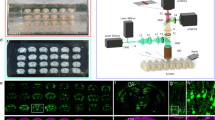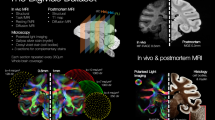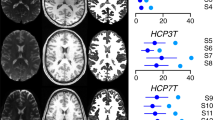Abstract
The unprecedented growth, availability and accessibility of imaging data from people with neurodegenerative conditions has led to the development of computational infrastructures, which offer scientists access to large image databases and e-Science services such as sophisticated image analysis algorithm pipelines and powerful computational resources, as well as three-dimensional visualization and statistical tools. Scientific e-infrastructures have been and are being developed in Europe and North America that offer a suite of services for computational neuroscientists. The convergence of these initiatives represents a worldwide infrastructure that will constitute a global virtual imaging laboratory. This will provide computational neuroscientists with a virtual space that is accessible through an ordinary web browser, where image data sets and related clinical variables, algorithm pipelines, computational resources, and statistical and visualization tools will be transparently accessible to users irrespective of their physical location. Such an experimental environment will be instrumental to the success of ambitious scientific initiatives with high societal impact, such as the prevention of Alzheimer disease. In this article, we provide an overview of the currently available e-infrastructures and consider how computational neuroscience in neurodegenerative disease might evolve in the future.
Key Points
-
Image data sets of unprecedented size from healthy and pathologically aging individuals are posing new challenges related to availability and accessibility of data, computational resources, and visualization tools
-
Scientific e-infrastructures based on grid computing, such as LONI, neuGRID, and CBRAIN, offer a suite of services to facilitate advanced computational analyses on brain images
-
In the neurodegenerative disease field, such e-infrastructures are critical to foster the development of disease markers for early diagnosis and to track the course of the disease in clinical trials
-
Steps have been taken towards convergence of the individual infrastructures into a worldwide, cloud-based global virtual imaging laboratory
This is a preview of subscription content, access via your institution
Access options
Subscribe to this journal
Receive 12 print issues and online access
$209.00 per year
only $17.42 per issue
Buy this article
- Purchase on Springer Link
- Instant access to full article PDF
Prices may be subject to local taxes which are calculated during checkout




Similar content being viewed by others
References
Alzheimer's Disease Neuroimaging Initiative (ADNI) [online], (2011).
The NIH MRI Study of Normal Brain Development [online], (2011).
[No authors listed] The scientific social network. Nat. Med. 17, 137 (2011).
Frisoni, G. B. & Weiner, M. W. Alzheimer's Disease Neuroimaging Initiative special issue. Neurobiol. Aging 31, 1259–1262 (2010).
Functional Connectomes Project [online], (2011).
Human Imaging Database [online], (2010).
OASIS [online], (2011).
Bipolar Disorder Neuroimaging Database (BiND) [online], (2009).
Multisite Imaging Research In the Analysis of Depression (MIRIAD). Biomedical Informatics Research Network [online], (2010).
Efficient Longitudinal Upload of Depression in the Elderly (ELUDE). Biomedical Informatics Research Network [online], (2010).
Laboratory of Neuro Imaging, UCLA (LONI) [online], (2009).
neuGRID [online], (2011).
CBRAIN [online], (2008).
Redolfi, A. et al. Grid infrastructures for computational neuroscience: the neuGRID example. Future Neurol. 8, 703–722 (2009).
Khachaturian, Z. S. & Khachaturian, A. S. Prevent Alzheimer's Disease by 2020: a national strategic goal. Alzheimers Dement. 5, 81–84 (2009).
PAD 2020: The Campaign to Prevent Alzheimer's Disease by 2020 [online], (2009).
Jessen, F. et al. A multicenter 1H-MRS study of the medial temporal lobe in AD and MCI. Neurology 72, 1735–1740 (2009).
Teipel, S. J. et al. Longitudinal changes in fiber tract integrity in healthy aging and mild cognitive impairment: a DTI follow-up study. J. Alzheimers Dis. 22, 507–522 (2010).
Dosenbach, N. U. et al. Prediction of individual brain maturity using fMRI. Science 329, 1358–1361 (2010).
NITRC [online], (2011).
Luo, X. J., Kennedy, D. N. & Cohen, Z. Neuroimaging Informatics Tools and Resources Clearinghouse (NITRC) resource announcement. Neuroinformatics 7, 55–56 (2009).
NeuroLog [online], (2007).
Montagnat, J. et al. NeuroLOG: a community-driven middleware design. Stud. Health Technol. Inform. 138, 49–58 (2008).
Frisoni, G. B. Alzheimer's Disease Neuroimaging Initiative in Europe. Alzheimers Dement. 6, 280–285 (2010).
LONI Pipeline [online], (2011).
Diagnostic Enhancement of Confidence by an International Distributed Environment (DECIDE) [online], (2011).
Klöppel, S. et al. Accuracy of dementia diagnosis: a direct comparison between radiologists and a computerized method. Brain 131, 2969–2974 (2008).
Morra, J. H. et al. Validation of a fully automated 3D hippocampal segmentation method using subjects with Alzheimer's disease mild cognitive impairment, and elderly controls. Neuroimage 43, 59–68 (2008).
CANARIE [online], (2009).
SPM [online], (2011).
Du, A. T. et al. Different regional patterns of cortical thinning in Alzheimer's disease and frontotemporal dementia. Brain 130, 1159–1166 (2007).
Avants, B. B., Cook, P. A., Ungar, L., Gee, J. C. & Grossman, M. Dementia induces correlated reductions in white matter integrity and cortical thickness: a multivariate neuroimaging study with sparse canonical correlation analysis. Neuroimage 15, 1004–1016 (2010).
Risacher, S. L. et al. Baseline MRI predictors of conversion from MCI to probable AD in the ADNI cohort. Curr. Alzheimer Res. 6, 347–361 (2009).
Kim, J. S. et al. Automated 3-D extraction and evaluation of the inner and outer cortical surfaces using a Laplacian map and partial volume effect classification. Neuroimage 27, 210–221 (2005).
Fischl, B. et al. Automatically parcellating the human cerebral cortex. Cereb. Cortex 14, 11–22 (2004).
Kochunov, P. et al. Relationship among neuroimaging indices of cerebral health during normal aging. Hum. Brain Mapp. 29, 36–45 (2007).
Kochunov, P. et al. Can structural MRI indices of cerebral integrity track cognitive trends in executive control function during normal maturation and adulthood? Hum. Brain Mapp. 30, 2581–2594 (2009).
The LONI Image Data Archive. Alzheimer's Disease Neuroimaging Initiative [online], (2011).
Dinov, I. et al. Neuroimaging study designs, computational analyses and data provenance using the LONI pipeline. PLoS ONE 5, pii: e13070 (2010).
LONI Pipeline Processing Environment. LONI Software [online], (2009).
outGRID [online], (2011).
eScience. Wikipedia [online], (2011).
Computational neuroscience. Wikipedia [online], (2011).
CBRAIN—Credits [online], (2008).
Acknowledgements
The authors thank all the partners in FP7 outGRID, FP7 neuGRID, LONI–ADNI and CBRAIN for collecting and providing information on main National and International virtual imaging laboratories. Special thanks go to Richard McClatchey, University of the West of England, Bristol, UK. G. B. Frisoni and D. Manset are supported by FP7 neuGRID and FP7 outGRID funded by the European Commission (FP7/2007-2013) under grant agreement no. 211,714 and no. 246,690, DG INFSO, e-Infrastructures. A. Toga was supported by NIH LONI–ADNI projects. A. Evans was supported by CANARIE Inc. and CBRAIN/GBRAIN projects.
Author information
Authors and Affiliations
Contributions
G. B. Frisoni developed the architecture of the manuscript. G. B. Frisoni and A. Redolfi drafted a first version, which was completed, edited, and reviewed for important intellectual content by D. Manset, M.-É. Rousseau, A. Toga and A. C. Evans.
Corresponding author
Ethics declarations
Competing interests
The authors declare no competing financial interests.
Supplementary information
Supplementary Table 1
Imaging processing algorithms and suites available in the three infrastructures (PDF 107 kb)
Rights and permissions
About this article
Cite this article
Frisoni, G., Redolfi, A., Manset, D. et al. Virtual imaging laboratories for marker discovery in neurodegenerative diseases. Nat Rev Neurol 7, 429–438 (2011). https://doi.org/10.1038/nrneurol.2011.99
Published:
Issue Date:
DOI: https://doi.org/10.1038/nrneurol.2011.99
This article is cited by
-
The A/T/N model applied through imaging biomarkers in a memory clinic
European Journal of Nuclear Medicine and Molecular Imaging (2020)
-
Small Animal Multivariate Brain Analysis (SAMBA) – a High Throughput Pipeline with a Validation Framework
Neuroinformatics (2019)
-
Neural predictors of cognitive improvement by multi-strategic memory training based on metamemory in older adults with subjective memory complaints
Scientific Reports (2018)
-
CATI: A Large Distributed Infrastructure for the Neuroimaging of Cohorts
Neuroinformatics (2016)
-
Childhood cognitive ability accounts for associations between cognitive ability and brain cortical thickness in old age
Molecular Psychiatry (2014)



